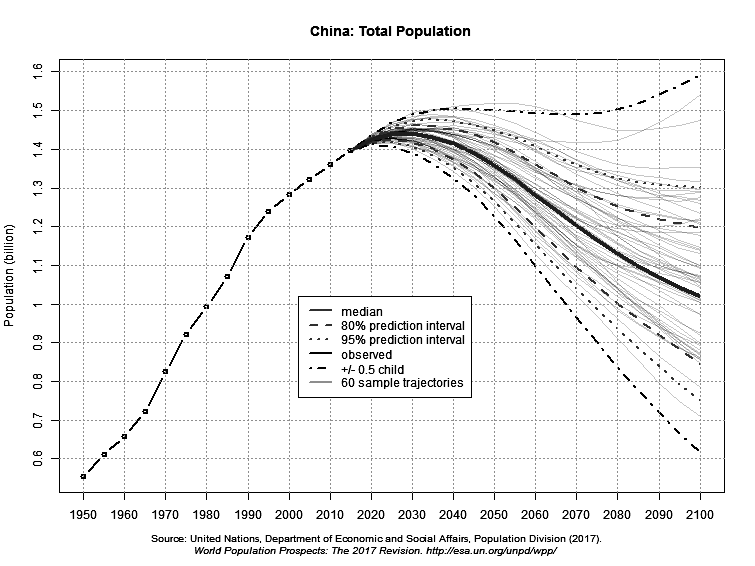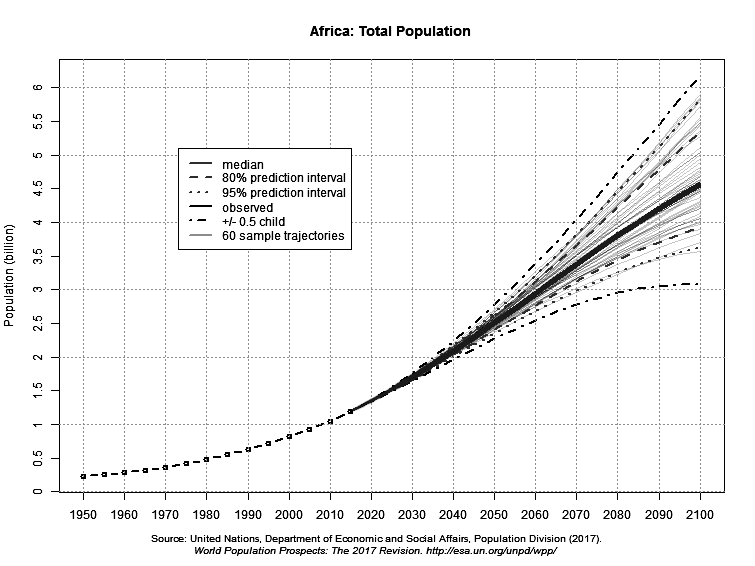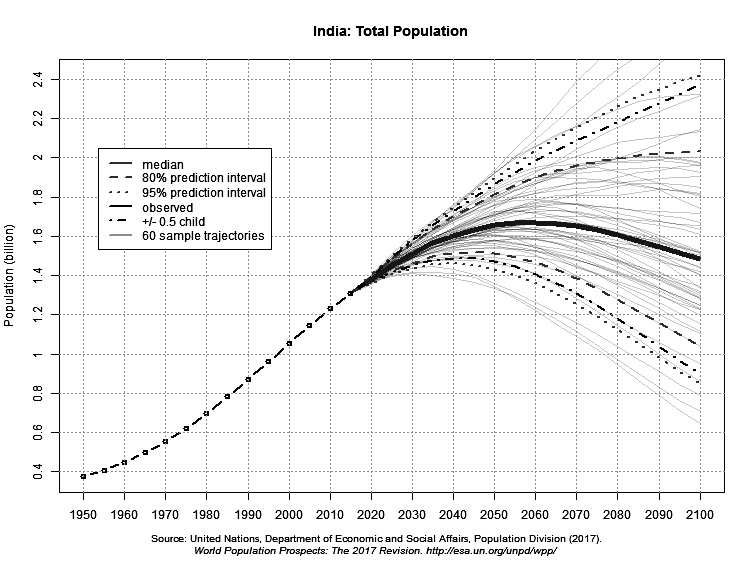China, fearing India, abandons population stabilization
Back in 1995, Lester R. Brown called attention to China's overpopulation crisis in the prescient book Who Will Feed China?: Wake-Up Call for a Small Planet.1 From the book's description:
To feed its 1.2 billion people, China may soon have to import so much grain that this action could trigger unprecedented rises in world food prices. In Who Will Feed China: Wake-up Call for a Small Planet, Lester Brown shows that even as water becomes more scarce in a land where 80 percent of the grain crop is irrigated, as per-acre yield gains are erased by the loss of cropland to industrialization, and as food production stagnates, China still increases its population by the equivalent of a new Beijing each year. When Japan, a nation of just 125 million, began to import food, world grain markets rejoiced. But when China, a market ten times bigger, starts importing, there may not be enough grain in the world to meet that need.…
Recognizing the unsustainable consequences of unconstrained population growth, China implemented in 1979 what was considered by many to be a draconian one-child policy. The policy was not universal, but applied to ethnic Han Chinese living in urban areas. The policy remained in effect for 35 years. The good news is that it reduced China's population by an estimated 300 million — approximately the population of the United States.2
From the article “China's Former One-Child Policy,”3
The one-child rule has been estimated to have reduced population growth in the country of nearly 1.4 billion (estimated, 2017) by as much as 300 million people over its first 20 years. Whether the male-to-female ratio eases with the discontinuation of the one-child policy will come clear over time…
China's total fertility rate (the number of births per woman)4 is 1.6, higher than slowly declining Germany at 1.45 but lower than the U.S. at 1.87 (2.1 births per woman is the replacement level of fertility, representing a stable population, exclusive of migration). The effect of the two-child rule hasn't made the population decline stabilize completely, but the law is young yet.…
The following 2017 UN Population Division graph shows projected Chinese population to the year 2100.5 The heavy middle line represents median population projection and can be considered the most likely projection.

It can be seen that China's population is projected to decline by 2100 to less than the population it had when Brown's book was published. Yet as explained below, China is now having second thoughts about this commendable achievement.
Africa's population explosion
The July 30, 2015 BBC article “India ‘to overtake China's population by 2022’ - UN”, explains that:6
The [UN] report also says that Nigeria will replace the US as the world's third most populous country by around 2050.
Africa is expected to account for more than half of the world's population growth over the next 35 years.
The current world population of 7.3 billion will reach 9.7 billion in 2050 and 11.2 billion in 2100, it predicts.
The new projection has India overtaking China's population six years earlier than previously predicted.
The reports says half of the world's population growth between 2015 and 2050 is expected to be concentrated in nine countries: India, Nigeria, Pakistan, the Democratic Republic of Congo, Ethiopia, Tanzania, the United States, Indonesia and Uganda.
The populations of 28 African countries are projected to more than double, and by 2100, 10 African countries are projected to have increased by at least a factor of five.…
The following UN graph depicts Africa's explosive population growth. The heavy middle line is the median projection.

Africa is projected to grow to a staggering 4.5 billion by the year 2100 and then keep on growing.
India's overpopulation and China's race to presumed demographic destiny will have significant impact on a finite and fragile planet. Yet the consequences of unconstrained population growth on the African continent will be truly gargantuan. Africa's population growth will remain a significant driving force in the relentless out-migration of Africans to Europe as the land of opportunity.7
India's overpopulation
India is projected to overtake China's population within a few short years — by 2022. And that scares China!
This UN graph shows India's projected population growth. The heavy middle line represents median, or most likely population.

The UN median projections show that India's population will peak in the year 2060 and then gradually decline to 1.5 billion. China, long considered to be the most populous nation, will see its population peak in 2020 and then decline more rapidly to about one billion by the 2100 — that is, to about two-thirds of India's population. It is presumed that population of China, India, and Africa will eventually stabilize at lower numbers. While China's engineered population decline was once national policy, China now considers it an impediment to their imperialist agenda.
The Chinese mindset
It's important to understand the Chinese mindset of racial superiority and their overarching agenda of global dominance. Tucker Carlson's March 15, 2019 interview with expert Gordon Chang, columnist and author of The Coming Collapse of China reveals a lot.8 Here are slected excerpts from the interview
GORDON CHANG: Well, breed-ready means they [Chinese women] are able to breed children. And the reason why is because China has declining demography.… And we are seeing that the workforce has already topped out. The population as a whole will top out soon. China's officials are just in a panic.
CARLSON: So they are identifying women who are breed-ready but then what do they do with that information? Is there going to be a coercive breeding program in China?
CHANG: There very possibly could be because some Chinese officials are now talking about having a two-child policy which is not a maximum two children, but they are talking about requiring couples to have two children.…
… the Chinese don't want to … [import people from the developing world] because they have a system and then basically, it's based on racial superiority where they do view the rest of the world in inferior terms.…
The world's most populous society will be India and the Chinese both disdain the Indians because of this racial superiority view but also, they fear India.…
This notion of Han superiority is bred into the Chinese political system and you see it, for instance, they put on a skit on the China Central Television’s program, 900 million people saw it that depicted Africans as primates and it is just incredible.…
China's imperialist destiny
In the book Bully of Asia: Why China's Dream is the New Threat to World Order, author Steven W. Mosher describes China's extensive history of politics based on raw power:9 Mosher observes that “offensive realists see the world as an anarchic system in which force is the ultimate arbiter.” Mosher documents that from the beginning of the Zhou dynasty in 1100 B.C. to the end of the Qing dynasty in 1911, China fought an incredible 3,790 wars!
Mosher emphasizes that it's critical to recognize that Chinese strategists are “offensive realists” and that they have been so for an extraordinarily long time. He writes:
The ba is a political order invented by ancient Chinese strategists twenty-eight hundred years ago that is based exclusively on naked power. Under the ba, as it evolved over the next six centuries, total control of a state’s population and resources was to be concentrated in the hands of the state’s hegemon, or bawang (literally “hegemon-king”), who would employ this power to establish his hegemony, or baquan (literally “hegemon-power”), over all the states in the known world.
Today, the national Chinese mindset is internally inconsistent and therefore somewhat dangerous. Historian William A. Callahan explains that while China's domination of their neighbors over the course of millennia has cultivated a superiority complex, their more recent clash with Western civilization has simultaneously engendered a national inferiority complex.10 Mosher observes that from the Chinese perspective, the U.S. is “containing” China simply by its presence in Asia — a presence that threatens China's perceived national security.
Mosher explains why Chinese feel inherently superior to other nationalities:
Among the specific traits that Han Chinese routinely point to as evidence of their unique genetic endowment of high intelligence is their superior cunning (jaohua in Chinese) as compared with the non-Han world. They disparage their chief rivals, the Americans, for being especially naïve and simple (danchun)…
Mosher observes that China sees America as the only power impeding Chinese hegemony, which they call the “World of Great Harmony,” stating:
China… sees America as a power in terminal decline, exhausted from decades of imperial overstretch and war. It looks forward to building its World of Great Harmony on the ashes of the existing world order… it imagines that it will be the dominant power on the planet. And it has made no secret of the fact that it is prepared to fight wars to achieve this end.
Mosher continues:
China is at war with the world (whether the world knows it or not) through its territorial claims in the South China sea and elsewhere, through its use of destabilizing proxies such as North Korea, and even more directly through its theft of technology, its currency manipulations, and its highly sophisticated and incessant cyberattacks.
The Chinese party-state therefore feels justified in using unrestricted and multifaceted warfare against the reigning hegemon — that is, America. Today China seeks deference, not equality, in international relations. Yet China's imperious agenda is not immediately obvious. As ancient strategist Sunzi (Sun Tzu) stated in The Art of War, “All warfare is based on deception.”11 China today masquerades as “a civilization pretending to be a nation," according to China scholar Lucian W. Pye.12
Demographic irrationality
The irrationality of unending population growth manifests differently in different countries:
-
In America, population doubling is driven by the Congressional mandate of mass immigration.
-
In India, population growth is driven by high fertility and population momentum.
-
In Africa, population growth is similarly driven by high fertility and population momentum.
- In China, population growth is driven by irrational views of racial superiority and demographic conquest.
When the currency of global domination is expressed in human population numbers, the threat of competing populations to China's global dominance is all too real. While the Chinese consider the United States to be a direct threat to their hegemony, America's population is dwarfed by China's numbers. Africa's burgeoning population numbers are huge, yet China considers Africans as inferior and geographically isolated and thus their numbers do not pose a direct threat. At present, China seems intent on obtaining Africa's natural resources via expanding trade routes. In contrast, neighboring India's growing population and technological progress makes India a direct contender for regional hegemony. Whether China ultimately returns to its successful policy of population reduction and stabilization remains to be seen.
Endnotes
1. Who Will Feed China?: Wake-Up Call for a Small Planet, by Lester R. Brown (Author) and Linda Starke (Series Editor), Worldwatch Institute, 1995.
2. “U.S. and World Population Clock,” United States Census Bureau.
3. “China's Former One-Child Policy — The Aftereffects of China's One-Child Policy”, ThoughtCo, viewed March 31, 2019.
4. Fertility is the actual reproductive performance of an individual, a couple, a group, or a population. It is typically used in reference to the average number of live births per woman. Native-born Americans voluntarily achieved replacement-level fertility (2.1 children per woman) in 1972.
Population momentum is the tendency for population growth to continue beyond the time that replacement-level fertility has been achieved because of the relatively high concentration of people in the childbearing years. It takes a period of time equal to the average life expectancy (approximately three generations or 73 years in the U.S.) for a reduction in fertility to be manifested as a change in actual population numbers.
5. “World Population Prospects: 2017 Revision”, Population Division, United Nations.
"World Population Prospects: 2017 Revision - graphs”, Population Division, United Nations.
6. “India ‘to overtake China's population by 2022’ - UN”, BBC, July 30, 2015.
7. “The Graph That Explains the 2015 Migrant Crisis — And another graph that explains the migrant crises of 2016-2100”, by Steve Sailer, Unz Review, September 19, 2015.
8. “China may institute 2 child minimum - Tucker Carlson 3/15/19,” Tucker Carlson interview with China expert Gordon Chang, Fox News, March 15, 2019. Video segment includes full transcript.
The Coming Collapse of China, Gordon G. Chang, Random House, July 31, 2001 (368 pp.), ISBN-10: 0812977564.
9. Bully of Asia: Why China's Dream is the New Threat to World Order, by Steven W. Mosher, Regnery Publishing, November 27, 2017 (256 pp.), ISBN-10: 1621576965.
10. China: The Pessoptimist Nation, by William A. Callahan, Oxford University Press, 2010 (266 pp.), ISBN-10: 0199549958.
11. The Art of War, by Sun Tzu, Filiquarian, 2007 (68 pp.), ISBN-10: 1599869772.
12. “International Relations in Asia: Culture, Nation, and State,” by Lucian W. Pye, The Sigur Center for Asian Studies, George Washington University, July 1992, p. 9.
Related
